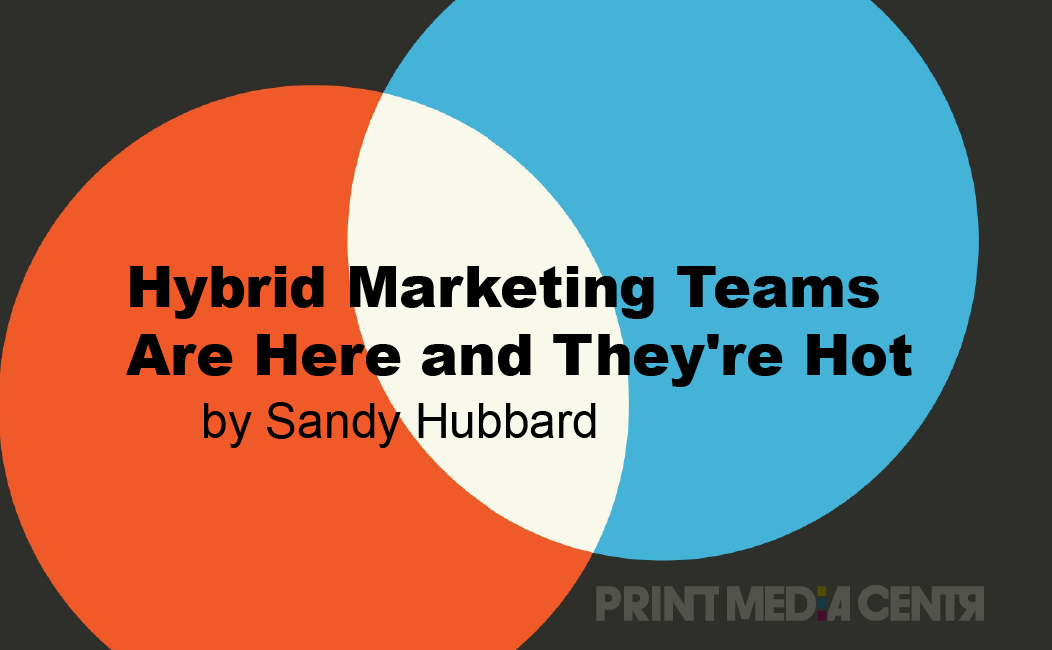Marketing departments in printing businesses are being disrupted. Today’s employees have been adjusting and adapting on the fly. Many have been deployed elsewhere during the pandemic. Most marketing people I talk to are carrying multiple roles within the company. They’re covering for other employees who need flexible time off, or they’re pivoting to address urgent priorities. Small departments can’t carry the load and don’t have the depth or redundancy to adjust if someone is needed elsewhere.
You can see why marketing departments — in printing and in all industries — are stalled and ineffective.
It takes a new way to achieve marketing effectiveness — and it starts with hybrid teams.
I’ll show you what that looks like in a moment, but I want to reiterate that we simply cannot return to outdated approaches to marketing. We just can’t.
The old way of staffing marketing teams doesn’t work.
- A single marcom executive who does everything.
- A solo marketing contractor.
- An internal team with no outside support.
- A staffer who tries to fit marketing around a full-time job in another department.
These approaches are not sustainable in today’s complex marketing environment. It takes a cohesive and strategic marketing TEAM to get traction and get things done.

Building hybrid marketing teams starts with a cross-section of members.
Hybrid marketing teams are made up of internal cross-trained employees plus external experts hired on contract. This combination is how you get the best marketing results — and it is the most affordable way to get the industry’s top brains working on your initiatives.
For a printing company, the hybrid marketing team may look like this:
Marketing VP or sales manager, a support and execution team, members from other departments, and a cadre of outside providers who are the best of class and who work well together.
A hybrid approach benefits team effectiveness.
In my work with client teams, once we assemble the team, it takes coaching to get everyone working together at their maximum potential. Unless your employees are used to working on cross-functional teams, it takes practice. However, once you are rolling, a hybrid marketing team is a highly flexible, collaborative, creative, and productive unit.
Other benefits include:
Marketing expertise: You can hire the best industry experts for a short period if you bring them in as advisors. Their experience working with other companies like yours is invaluable. Often they’ve been in the industry for decades and have connections that can save time and open doors.
Affordability: Your utility players — independent contractors who can step in and cover a variety of positions — often can be obtained for a modest retainer. They attend team meetings, read the emails and follow threads in your project app, and can jump in at a moment’s notice to answer a question or solve a problem.
Reliability: Choose contractors with impeccable credentials — the top one being reliability. You want people who can get things done, are good at Zoom meetings, pull their weight, and work well with others. Any provider who has tantrums or goes dark without explanation is off my team.
Collaboration: As the team’s marketing strategist, I’m often asked to help source providers. This might be an SEO expert, marketing automation specialist, sales trainer, or website designer. I’ll find and vet the provider before I bring the person in to assess our needs and create a proposal. If the provider can’t work in our team environment, generally that’s a no-go.
Technical Know-How: With a solid hybrid team, we usually have the bases covered. We also will lean on the client’s IT department, technical sales people, vendors, and the executive team for vision and direction.
As you can see, a hybrid marketing team is built for success.
Hybrid teams require an adjustment within the organization.
A hybrid team approach can be an adjustment for top-down hierarchies. Some executives are uncomfortable with teams that have high-powered external providers. In companies where information is siloed and hoarded, the transparency required by hybrid teams can seem threatening. And yet, many winning companies find hybrid teams to be the way forward.
How does that look in execution?
Self-management: These expanded teams have a flatter org chart, not layers of people who report to the next level up. There may be a scrum master to deal with obstacles or a project manager to help the team stay on track. Other than that, we’re all adults, and we want to be successful, so we don’t need micro-managing. That opens up an incredible amount of capacity at the C-level for high-level strategy because the executing teams are self-managing.
Investment: Adding contractors and allocating internal resources will cost more than you expected. Will you see better ROI? I believe you will, especially if your team is coached properly and runs optimally.
Competitiveness: Hybrid marketing teams are still a novelty in the printing industry, though they are standard in most high-tech and software-as-a-service (SaaS) businesses. We can take the best knowledge about hybrid teams and apply it to print manufacturing to achieve top results.
Communication: Yes, there will be more meetings. More emails. More apps. More need for clarity. More training and support. Because communication is crucial for hybrid teams, your people will become good at it because they want to be.
Management buy-in: The hybrid marketing team will need a budget, agreed-upon deliverables, a realistic schedule (sprints), and regular planning sessions. Hybrid teams rely on management to give the program the funding, support, and leadership needed.
Coaching: A person experienced and certified in coaching or facilitating hybrid teams will unify the team and keep things moving. As the team improves its self-management, my role as scrum master or facilitator evolves. Once the hybrid team is able to implement the organizational vision, I can work with the executive team and help them serve in their leadership role more effectively.
The organization as a whole will benefit from the deployment of hybrid marketing teams.
In my work with hybrid marketing teams, the organization became better at dealing with adversity, solving problems, delivering products or outcomes, and using technology.
Well-functioning hybrid teams are confident, empowered, and effective. Their effectiveness tends to be a role model to the rest of the company, and many of my clients have incorporated hybrid teams in other departments as well. Success begets success.
An unexpected benefit of having hybrid marketing teams is the much-needed camaraderie between workers who were isolated during the pandemic. In my teams, members tell me they look forward to working on projects because we work in an atmosphere of respect, positivity, trust, and empowerment.
Hybrid teams are closer than you think.
I’m curious what’s on your radar when it comes to hybrid teams.
Have you noticed marketing teams — yours and others — evolving? Are you seeing the need for more skills on your teams? Do you need outside help but aren’t sure if a hybrid approach would work for your situation?
Let me know if you’d like to learn more. I’m happy to discuss how hybrid marketing teams can excel within today’s printing companies.
Read more from Sandy here: https://printmediacentr.com/author/sandyhubbard/
 Sandy Hubbard is a Marketing Strategist with 40 years of expertise in the Printing Industry. She consults with CEOs, founders, VPs of Sales and Marketing, and leaders of all types who make printers successful.
Sandy Hubbard is a Marketing Strategist with 40 years of expertise in the Printing Industry. She consults with CEOs, founders, VPs of Sales and Marketing, and leaders of all types who make printers successful.
Sandy is the co-host of #PrintChat, a weekly discussion on LinkedIn. Join the group here — and enjoy the fun at social media’s most popular chat for the global printing industry!
Video excerpt: Sandy Hubbard talks about helping printing companies build Hybrid Sales and Marketing Teams











